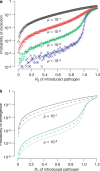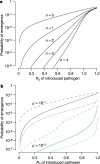The role of evolution in the emergence of infectious diseases
- PMID: 14668863
- PMCID: PMC7095141
- DOI: 10.1038/nature02104
The role of evolution in the emergence of infectious diseases
Abstract
It is unclear when, where and how novel pathogens such as human immunodeficiency virus (HIV), monkeypox and severe acute respiratory syndrome (SARS) will cross the barriers that separate their natural reservoirs from human populations and ignite the epidemic spread of novel infectious diseases. New pathogens are believed to emerge from animal reservoirs when ecological changes increase the pathogen's opportunities to enter the human population and to generate subsequent human-to-human transmission. Effective human-to-human transmission requires that the pathogen's basic reproductive number, R(0), should exceed one, where R(0) is the average number of secondary infections arising from one infected individual in a completely susceptible population. However, an increase in R(0), even when insufficient to generate an epidemic, nonetheless increases the number of subsequently infected individuals. Here we show that, as a consequence of this, the probability of pathogen evolution to R(0) > 1 and subsequent disease emergence can increase markedly.
Conflict of interest statement
The authors declare that they have no competing financial interests.
Figures



Comment in
-
Virus evolution: epidemics-in-waiting.Nature. 2003 Dec 11;426(6967):609-10. doi: 10.1038/426609a. Nature. 2003. PMID: 14668840 Free PMC article.
References
-
- Anderson R, May R. Infectious Diseases of Humans: Dynamics and Control. 1991.
-
- Wallace B. Can “stepping stones” form stairways? Am. Nat. 1989;133:578–579. doi: 10.1086/284937. - DOI
Publication types
MeSH terms
LinkOut - more resources
Full Text Sources
Other Literature Sources
Medical
Miscellaneous

